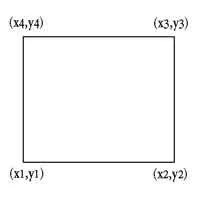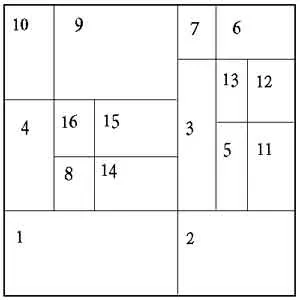描述
假设一个矩形的4个边的坐标分别为(x1,y1), (x2,y2),(x3,y3) 和 (x4,y4),如下图所示-

我有一个包含100000个矩形坐标的文本文件。例如,以下是由我的代码生成的16个矩形的坐标值-
#Rect x1 y1 x2 y2 x3 y3 x4 y4 area
1 0.0000 0.0000 0.8147 0.0000 0.8147 0.1355 0.0000 0.1355 0.1104
2 0.8147 0.0000 1.0000 0.0000 1.0000 0.1355 0.8147 0.1355 0.0251
3 0.8147 0.1355 0.9058 0.1355 0.9058 0.8350 0.8147 0.8350 0.0637
4 0.0000 0.1355 0.1270 0.1355 0.1270 0.9689 0.0000 0.9689 0.1058
5 0.9058 0.1355 0.9134 0.1355 0.9134 0.2210 0.9058 0.2210 0.0006
6 0.9058 0.8350 1.0000 0.8350 1.0000 1.0000 0.9058 1.0000 0.0155
7 0.8147 0.8350 0.9058 0.8350 0.9058 1.0000 0.8147 1.0000 0.0150
8 0.1270 0.1355 0.6324 0.1355 0.6324 0.3082 0.1270 0.3082 0.0873
9 0.1270 0.9689 0.8147 0.9689 0.8147 1.0000 0.1270 1.0000 0.0214
10 0.0000 0.9689 0.1270 0.9689 0.1270 1.0000 0.0000 1.0000 0.0040
11 0.9134 0.1355 1.0000 0.1355 1.0000 0.2210 0.9134 0.2210 0.0074
12 0.9134 0.2210 1.0000 0.2210 1.0000 0.8350 0.9134 0.8350 0.0532
13 0.9058 0.2210 0.9134 0.2210 0.9134 0.8350 0.9058 0.8350 0.0047
14 0.6324 0.1355 0.8147 0.1355 0.8147 0.3082 0.6324 0.3082 0.0315
15 0.6324 0.3082 0.8147 0.3082 0.8147 0.9689 0.6324 0.9689 0.1205
16 0.1270 0.3082 0.6324 0.3082 0.6324 0.9689 0.1270 0.9689 0.3339
这些坐标将一个单位正方形分割成子矩形,如下图所示 - 
最近的矩形示例
在上图中,矩形# 3的最近矩形为9、15、14、1、2、5、13、6和7。
对于矩形# 9,它们是10、4、16、15、3和7。
我的问题
现在我想使用c / c ++计算每个矩形的最近矩形数。我该怎么做?
编辑:根据回复
#include <iostream>
#include <vector>
#include <fstream>
using namespace std;
struct Rectangle {
double x1, y1;
double x2, y2;
double x3, y3;
double x4, y4;
};
vector<double> get_touching_rectangles(Rectangle base, vector<Rectangle> rectangles) {
for (auto it = rectangles.begin(); it != rectangles.end(); it++) {
Rectangle other = *it;
if (base == other) {
continue; // This is our rectangle... skip it
}
// Top or bottom
if ((other.x2 >= base.x1 && other.x1 <= base.x2) && (other.y1 == base.y3 || other.y3 == base.y1)) {
ret.push_back(other);
continue;
}
// Left or right
if ((other.y3 >= base.y2 && other.y2 <= base.y3) && (other.x1 == base.x3 || other.x3 == base.x1)) {
ret.push_back(other);
continue;
}
}
return ret;
}
int main(int argc, char const *argv[])
{
vector<Rectangle> rectangles;
//parse_txt_file(file, &rectangles); // Or whateer I need to do to parse that .txt file
ifstream inputFile;
inputFile.open("RectCoordinates.txt");
//std::vector<Rectangle> touching =
get_touching_rectangles(rectangles.at(2) /* Rectangle #3 */, rectangles);
inputFile.close();
return 0;
}
好的,我基于反馈编写了上述代码。但它显示以下错误-
g++ -std=c++11 st5.cpp -o ssst5.cpp: In function ‘std::vector<double> get_touching_rectangles(Rectangle, std::vector<Rectangle>)’:
st5.cpp:23:21: error: no match for ‘operator==’ in ‘base == other’
st5.cpp:23:21: note: candidates are:
In file included from /usr/include/c++/4.7/iosfwd:42:0,
from /usr/include/c++/4.7/ios:39,
from /usr/include/c++/4.7/ostream:40,
from /usr/include/c++/4.7/iostream:40,
from st5.cpp:1:
/usr/include/c++/4.7/bits/postypes.h:218:5: note: template<class _StateT> bool std::operator==(const std::fpos<_StateT>&, const std::fpos<_StateT>&)
/usr/include/c++/4.7/bits/postypes.h:218:5: note: template argument deduction/substitution failed:
st5.cpp:28:13: error: ‘ret’ was not declared in this scope
st5.cpp:33:13: error: ‘ret’ was not declared in this scope
st5.cpp:37:12: error: ‘ret’ was not declared in this scope
我做错了什么?